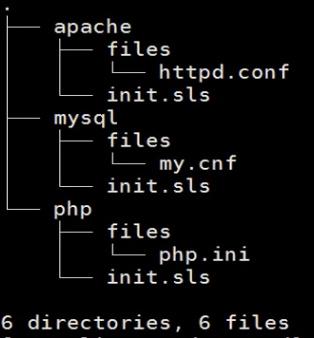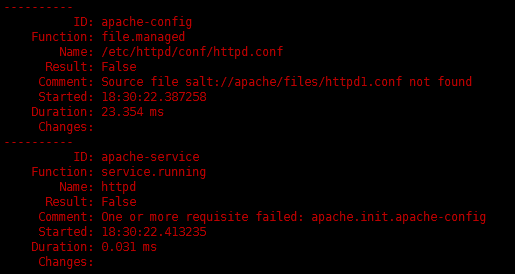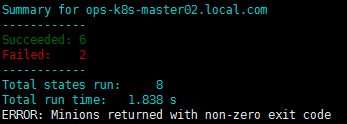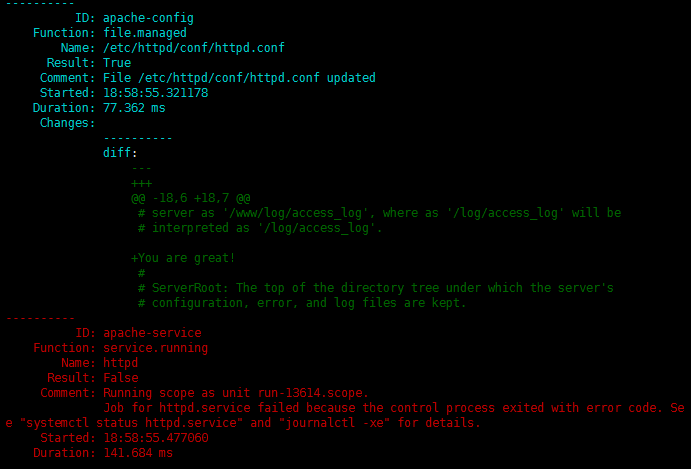一、saltstack的SSH工作模式
一、salt-ssh介绍
- salt-ssh 是 0.17.0 新引入的一个功能,不需要minion对客户端进行管理,也不需要master。
- salt-ssh 支持salt大部分的功能:如 grains、modules、state 等
- salt-ssh 没有使用ZeroMQ的通信架构,执行是串行模式
- salt-ssh和salt-minon可以共存,salt-minion不依赖ssh服务
类似 paramiko、pssh、ansible 这类的工具
二、Roster使用
salt-ssh需要一个名单系统来确定哪些执行目标,Salt的0.17.0版本中salt-ssh引入roster系统
roster系统编译成了一个数据结构,包含了targets,这些targets是一个目标系统主机列表和或如连接到这些targets
配置文件如下
# target的信息
host: # 远端主机的ip地址或者dns域名
user: # 登录的用户
passwd: # 用户密码,如果不使用此选项,则默认使用秘钥方式
# 可选的部分
port: #ssh端口
sudo: #可以通过sudo
tty: # 如果设置了sudo,设置这个参数为true
priv: # ssh秘钥的文件路径
timeout: # 当建立链接时等待响应时间的秒数
minion_opts: # minion的位置路径
thin_dir: # target系统的存储目录,默认是/tmp/salt-<hash>
cmd_umask: # 使用salt-call命令的umask值三、salt-ssh安装配置
1、安装salt-ssh
yum install salt-ssh -y2、修改roster文件,配置要管理的机器
# tail -11 /etc/salt/roster
linux-node1.example.com:
host: 192.168.56.11
user: root
passwd: 123456
port: 22
linux-node2.example.com:
host: 192.168.56.12
user: root
passwd: 123456
port: 223、管理测试
# salt-ssh '*' test.ping -i
linux-node1.example.com:
True
linux-node2.example.com:
True4、salt-ssh命令用法
-r, --raw, --raw-shell # 直接使用shell命令
--priv #指定SSH私有密钥文件
--roster #定义使用哪个roster系统,如果定义了一个后端数据库,扫描方式,或者用户自定义的的roster系统,默认的就是/etc/salt/roster文件
--roster-file #指定roster文件
--refresh, --refresh-cache #刷新cache,如果target的grains改变会自动刷新
--max-procs #指定进程数,默认为25
-i, --ignore-host-keys #当ssh连接时,忽略keys
--passwd #指定默认密码
--key-deploy #配置keys 设置这个参数对于所有minions用来部署ssh-key认证, 这个参和--passwd结合起来使用会使初始化部署很快很方便。当调用master模块时,并加上参数 --key-deploy 即可在minions生成keys,下次开始就不使用密码5、salt-ssh执行状态模块
salt-ssh '*' state.sls php.init 二、配置管理
状态写的应该是每次执行都是对的
一、状态间关系:实战------搭建LAMP环境
每个组件分开创建,以后可以复用(使用include)
salt:// 所处环境的根路径
1、基础环境
cd /srv/salt/prod
mkdir -p {apache,php,mysql}1、Apache
apache-install:
pkg.installed:
- name: httpd
apache-config:
file.managed:
- name: /etc/httpd/conf/httpd.conf
- source: salt://apache/files/httpd.conf
- user: root
- group: root
- mode: 644
apache-service:
service.running:
- name: httpd
- enable: True2、PHP
php-install:
pkg.installed:
- pkgs:
- php
- php-pdo
- php-mysql
php-config:
file.managed:
- name: /etc/php.ini
- source: salt://php/files/php.ini
- user: root
- group: root
- mode: 6443、MySQL
mysql-install:
pkg.installed:
- pkgs:
- mariadb
- mariadb-server
mysql-config:
file.managed:
- name: /etc/my.cnf
- source: salt://mysql/files/my.cnf
- user: root
- group: root
- mode: 644
mysql-service:
service.running:
- name: mariadb
- enable: True写完如下图(file下配置文件,是环境中拷贝过去的)

2、使用远程执行操作,指定statenv
#安装php
salt -S '10.0.0.10' state.sls php.init saltenv=prod
#安装MySQL
salt -S '10.0.0.10' state.sls mysql.init saltenv=prod3、使用高级状态,将下面写入top file
vim /srv/salt/base/top.sls
prod:
'ops-k8s-master01.local.com':
- apache.init
- php.init
- mysql.init执行高级状态
salt 'ops-k8s-master01*' state.highstate4、top file中使用include
https://docs.saltstack.com/en/latest/topics/tutorials/states_pt3.html
在prod环境创建lamp.sls使用include,将所需组件写进入,在top file引用lamp
vim /srv/salt/prod/lamp.sls
include:
- apache.init
- php.init
- mysql.init更改top file,vim /srv/salt/base/top.sls
prod:
'ops-k8s-master02.local.com':
- lamp执行高级状态
salt 'ops-k8s-master02*' state.highstate5、扩展功能:extend
States tutorial, part 3 - Templating, Includes, Extends
示例:扩展PHP的扩展包,更改一下lamp.sls即可
vim /srv/salt/prod/lamp.sls
include:
- apache.init
- php.init
- mysql.init
extend:
php-install:
pkg.installed:
- name: php-mbstring执行高级状态
salt 'ops-k8s-master02*' state.highstate6、依赖/被依赖:require/require_in
States tutorial, part 2 - More Complex States, Requisites
1、我依赖谁:require
以Apache的配置举例,更改apache/init.sls,添加依赖并改错一下配置文件
apache-install:
pkg.installed:
- name: httpd
apache-config:
file.managed:
- name: /etc/httpd/conf/httpd.conf
- source: salt://apache/files/httpd1.conf
- user: root
- group: root
- mode: 644
apache-service:
service.running:
- name: httpd
- enable: True
- require:
- pkg: apache-install
- file: apache-config执行高级状态,报错信息如下
salt 'ops-k8s-master02*' state.highstate

验证服务状态

2、我被谁依赖:require_in
以Apache的配置举例,更改apache/init.sls,添加依赖并改错一下配置文件(红色是添加的功能)
apache-install:
pkg.installed:
- name: httpd
- require_in:
- service: apache-service
apache-config:
file.managed:
- name: /etc/httpd/conf/httpd.conf
- source: salt://apache/files/httpd.conf
- user: root
- group: root
- mode: 644
- require_in:
- service: apache-service
apache-service:
service.running:
- name: httpd
- enable: True执行高级状态
salt 'ops-k8s-master02*' state.highstate7、监听/被监听:watch/watch_in
1、监听:watch
reload: True 文件变动,执行重载
以Apache的配置举例,更改apache/init.sls,添加依赖并改错一下配置文件(红色是添加的功能)
apache-install:
pkg.installed:
- name: httpd
apache-config:
file.managed:
- name: /etc/httpd/conf/httpd.conf
- source: salt://apache/files/httpd.conf
- user: root
- group: root
- mode: 644
apache-service:
service.running:
- name: httpd
- enable: True
- reload: True
- watch:
- file: apache-config执行高级状态
salt 'ops-k8s-master02*' state.highstate若文件修改错误,执行完,启动报错如下(salt返回值,会告知更改了什么)

若文件修改没有问题,执行完返回的状态如下

2、被监听:watch_in
以Apache的配置举例,更改apache/init.sls,添加依赖并改错一下配置文件(红色是添加的功能)
apache-install:
pkg.installed:
- name: httpd
apache-config:
file.managed:
- name: /etc/httpd/conf/httpd.conf
- source: salt://apache/files/httpd.conf
- user: root
- group: root
- mode: 644
- watch_in:
- service: apache-service
apache-service:
service.running:
- name: httpd
- enable: True
- reload: True执行高级状态,不报错就OK了
salt 'ops-k8s-master02*' state.highstate8、条件判断:unless
unless:除非后面的条件满足,不然就执行操作
需求:若文件存在,就不执行操作;若文件不存在就执行()
解决:如何判断一个文件是否存在,test -f /path/xxx
换言之即: 条件为假,就执行
1、更改httpd的配置文件,加上用户认证
在apache/files/httpd.conf添加下面的代码
<Directory "/var/www/html/admin">
AllowOverride AuthConfig
AuthType Basic
AuthName "you guess"
AuthUserFile /etc/httpd/conf/htpasswd_file
Require user admin
</Directory>创建示例代码
mkdir -p /var/www/html/admin
echo "User Authentication">> /var/www/html/admin/index.html2、更改状态文件
以Apache的配置举例,更改apache/init.sls,添加依赖并改错一下配置文件(红色是添加的功能)
apache-install:
pkg.installed:
- name: httpd
apache-config:
file.managed:
- name: /etc/httpd/conf/httpd.conf
- source: salt://apache/files/httpd.conf
- user: root
- group: root
- mode: 644
- watch_in:
- service: apache-service
apache-auth:
pkg.installed:
- name: httpd-tools
cmd.run:
- name: htpasswd -bc /etc/httpd/conf/htpasswd_file admin admin
- unless: test -f /etc/httpd/conf/htpasswd_file
apache-service:
service.running:
- name: httpd
- enable: True
- reload: True3、执行高级状态,不报错就OK了
salt 'ops-k8s-master02*' state.highstate二、jinja模板
saltstack模板:States tutorial, part 3 - Templating, Includes, Extends
jinja模板:欢迎来到 Jinja2 --- Jinja2 2.7 documentation
需求:不同的主机不同的配置文件
1、实现方式一:
1、更改模板文件
vim apache/files/httpd.conf
Listen {{ IPADDR }}:{{ PORT }}2、更改状态文件
vim apache/init.sls
apache-install:
pkg.installed:
- name: httpd
apache-config:
file.managed:
- name: /etc/httpd/conf/httpd.conf
- source: salt://apache/files/httpd.conf
- user: root
- group: root
- mode: 644
- template: jinja
- defaults:
PORT: 80
IPADDR: {{ grains['fqdn_ip4'][0] }}
- watch_in:
- service: apache-service
apache-auth:
pkg.installed:
- name: httpd-tools
cmd.run:
- name: htpasswd -bc /etc/httpd/conf/htpasswd_file admin admin
- unless: test -f /etc/httpd/conf/htpasswd_file
apache-service:
service.running:
- name: httpd
- enable: True
- reload: True3、执行高级状态
salt 'ops-k8s-master02*' state.highstate2、实现方式二:
1、更改模板文件
vim apache/files/httpd.conf
Listen {{ grains['fqdn_ip4'][0] }}:{{ PORT }}2、更改状态文件
vim apache/init.sls
apache-install:
pkg.installed:
- name: httpd
apache-config:
file.managed:
- name: /etc/httpd/conf/httpd.conf
- source: salt://apache/files/httpd.conf
- user: root
- group: root
- mode: 644
- template: jinja
- defaults:
PORT: 80
- watch_in:
- service: apache-service
apache-auth:
pkg.installed:
- name: httpd-tools
cmd.run:
- name: htpasswd -bc /etc/httpd/conf/htpasswd_file admin admin
- unless: test -f /etc/httpd/conf/htpasswd_file
apache-service:
service.running:
- name: httpd
- enable: True
- reload: True3、执行高级状态
salt 'ops-k8s-master02*' state.highstate